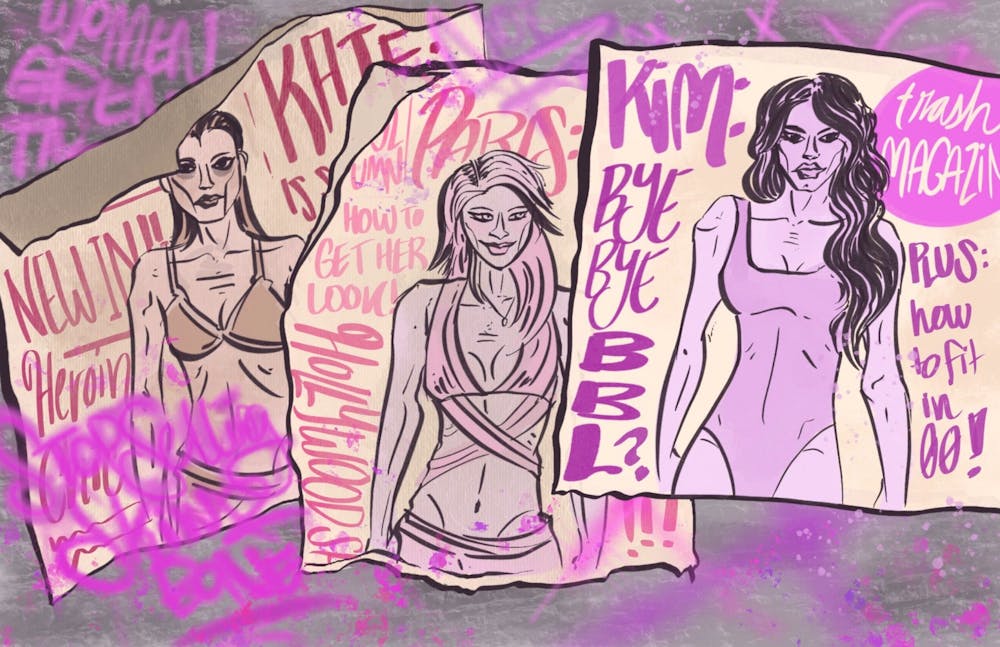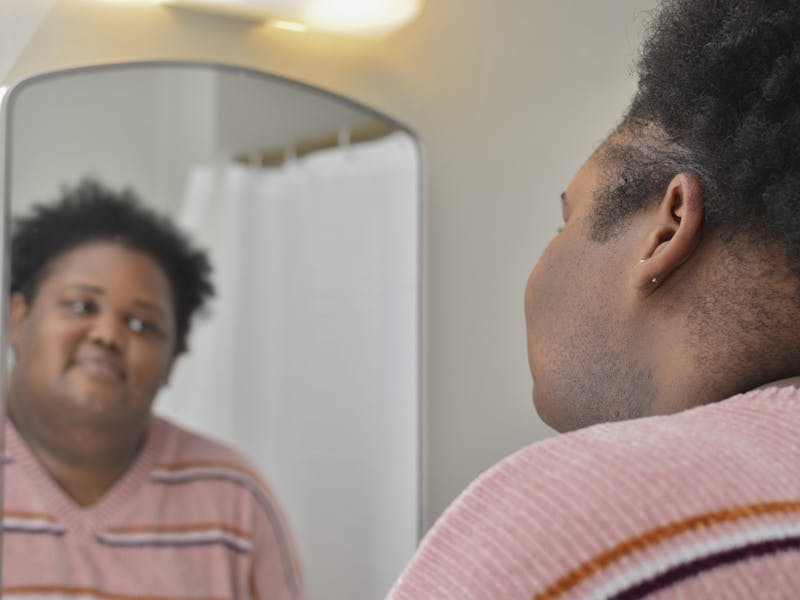TW: Mentions of eating disorders and body dysmorphia.
“Nothing tastes as good as skinny feels.”
Popularized by British model Kate Moss in a 2009 interview, this statement resulted in almost immediate backlash claiming that Moss was promoting eating disorder culture as a means of maintaining a thin appearance. It reignited the hot debate about the extent to which the words and actions of highly esteemed models and celebrities affect the way that everyday women view their own bodies. Beauty standards start and end at the top, and in a matter of just a few years, trends can undergo drastic changes that create a demand for body augmentation and result in widespread body dysmorphia.
However, there are people who have been fighting to show that these body standards are arbitrary, fickle and a poor indicator of happiness or even true beauty. Hundreds of TikTok pages, YouTube accounts or even just conversations among friends have attempted to promote health-conscious habits such as intuitive eating and attention to mental health. While there is hope that beauty culture will shift drastically to be more inclusive as time goes on, we must understand how the past few decades have impacted body standards today.
Beauty trends of the 1990s and the early 2000s are often characterized by their glamorization of drug abuse and the promotion of unhealthy relationships with food. Kate Moss and other models known for their size zero body type contributed to the popularization of the “heroin chic” era which dominated the 1990s runway aesthetic. Fashion icons who embodied this drug abuse-inspired trend presented themselves with traits that are commonly associated with users of heroin: pale skin, stringy hair, dark circles and an appearance of general poor health.
This glamorization contributed to an increase in the use of heroin in the 1990s, and it also left a generational impact on how women viewed the relationship between their health and their beauty. A lack of attention to physical well-being can be indicative of mental illnesses such as depression and anxiety, and these too became things that were portrayed in an appealing or even a sexy light. Sad girls were pretty girls, and pretty girls were skinny.
The mid-to-late 2000s still ascribed to the thin beauty standard, but the trend got a makeover to account for the new obsession with toned, athletic bodies and glowing fake tans. The pale, waiflike craze of the 1990s began to fade and was replaced by the bottle-blonde West Coast aesthetic of celebrities like Paris Hilton and Britney Spears. This take on beauty was inherently whitewashed and has been criticized for its exclusion of BIPOC communities.
Additionally, it promoted a very unrealistic — and in most cases unachievable — body proportion standard. The 2000s ushered in unprecedentedly rapid growth in the plastic surgery industry, both in product development and overall demand for its services. Women were expected to be thin but also curvy in the right places: if someone was naturally skinny but then didn’t have large breasts, it was expected that they would undergo augmentations in order to mold their bodies into the desired look.
“I only feel pretty when I’m hungry.”
This sentiment was thrown around all over social media after the mass popularization of online communication among teenagers in the early 2010s. The most notable platform for this among young women was Tumblr. The rise and fall of the “Tumblr girl” has been discussed for years, and the subculture's obsession with aesthetics resulted in the rise of what is now called “coquette,” an offshoot of the heroin chic era that raises some concerning questions about the role of the male gaze in female beauty standards.
Published in 1955 by Vladimir Nabokov, "Lolita" remains one of the most controversial books in discussion because its perceived glamorization of a manipulative romantic relationship between a 12-year-old girl, Lolita, and a man in his late thirties. Regardless of the book’s problematic nature, it had a massive impact on general feelings toward beauty after its rediscovery by the Tumblr crowd. Aesthetics Wiki describes the craze as “an aesthetic surrounding femininity, tragedy and burgeoning sexuality.”
While there is nothing wrong with women reclaiming their sexuality in response to abuse by their male counterparts, its depiction by and for teenage girls during the 2010s suggested that a woman needed to be mentally tortured and exploited in order to tap into their feminine core. It indirectly asserted that abuse by men was a critical part of maturing into womanhood, which cannot be further from the truth. Especially after its integration into pop culture by artists such as Lana Del Rey, the coquette aesthetic permeated the beauty industry and reignited interest in the “sad girl.”
In direct contrast to the Tumblr girl, many girls who grew up in the 2010s will remember it as an age of innocence and Disney Channel. They recall their favorite shows, filled with tall, thin, beautiful girls who were often struggling with body image issues themselves because of the pressure placed on them to look the part at all times.
In 2018, Dove Cameron, one of Disney Channel’s most beloved stars from the 2010s, shared in an interview with Teen Vogue about her struggles with anorexia and how body standards impacted her self-image. "I was not eating for days sometimes. But it was because I thought I needed to be absolutely tiny to be loved. I genuinely thought I needed to be as skinny as I possibly could to be loved and appreciated and good enough." Cameron shared her personal issues with the way that fitness and health are portrayed to young girls, especially when they are told that if they follow a set of rules, like watch what you eat, work out, etc., then they too can look like the Disney Channel beauty queens.
The mindset that Cameron carried with her for so long has found its way into the minds of young, impressionable girls who will grow up to think that they have to look a certain way to be worthy of love and happiness. In recent years, there has been a massive effort to confront these problems, and people from all backgrounds are speaking out more than they ever have. As Chrissy Teagan said:
"We've forgotten what a regular body looks like."
The most powerful body influencers of the late 2010s and 2020s are without a doubt the Kardashian-Jenner family. Their world famous exaggerated hourglass body types have become the modern marvel of the beauty industry, most notably those of Kim Kardashian and Kylie Jenner. While it still highlights the importance of a skinny waist and a thin face, the “Kardashian body” also emphasizes the need for large breasts and a large butt.
Sarah McComb, a researcher with the York University Department of Psychology, shared her thoughts on the dangers of the slim-thick body type in an interview with Yahoo Canada: “The thin-ideal has long been identified as a threat to women’s body image, and there’s been a call for body image campaigns and the media to showcase a greater diversity of body types. However, even though the slim-thick body type touts a larger frame, it is not a healthier alternative to the thin-ideal for media consumers — it was actually more threatening to women’s body image.”
Since the proportions of the slim-thick body are so often completely unattainable naturally, women will undergo risky or dangerous body augmentation processes or use waist trainers in order to add more volume to the curvaceous parts of their bodies. BBLs and similar alterations have skyrocketed in popularity, as have a collection of face fillers known commonly as the “Kylie package” among plastic surgeons.
Social media has also led to the popularization of the “that girl", which Glam describes in a 2022 article said, “The ‘that girl’ trend is characterized by its similarities to other aesthetic lifestyles, like the ‘clean girl’ or ‘off-duty model’ aesthetics. ‘That girl’ is a #GirlBoss who puts in the work to have the life of her dreams while also embracing the mantra of slow living and letting things play out as they will.”
The trend often manifests itself in the form of aesthetic videos on TikTok portraying conventionally beautiful young women detailing their daily routines, which commonly feature strenuous workouts, kale smoothies and extensive attention to mental health. While these videos are not harmful in themselves, it has been argued that they depict unrealistic standards of living that the average person cannot meet either because of their appearance or because of their budget. The “that girl" trend has been criticized for its themes of pretty privilege and disproportionate whiteness. While the women who participate in the trend do not have malicious intentions when it comes to perpetuating toxic beauty standards, the association of healthy living and happiness with thinness and conventional attractiveness is absolutely detrimental to their impressionable viewers.
Western beauty standards have been unbelievably Eurocentric for centuries, and the increasing popularity of social media has resulted in a more drastically similar shared idea of what true beauty looks like across different countries. In places such as China and India, colorist prejudices have taken hold because of this global obsession with "white" beauty, and women and men alike undergo processes to lighten their skin. Other nontraditionally European features are seen as less desirable as well, such as wide noses and unhooded eyes. This has contributed to an increase in plastic surgery in countries such as South Korea, which accounts for 24 percent of all plastic surgeries globally. Lisa Wade, a professor of sociology at Tulane University, says, "Non-white people are still allowed to be considered beautiful, of course, as long as they look like white people."
The rise of Instagram and TikTok has also played a crucial role in the rapid spread of body image trends. What used to take a decade to filter out can now be a trend that begins and ends within a matter of a few years. The Kardashian body took hold in society around 2015, and Kim Kardashian’s announcement that she is removing her BBL has raised some questions about what kinds of bodies will be trending in the coming years.
In an article by Dazed Beauty, it is explained that “it’s unlikely articles or trend forecasters will declare the return of heroin chic in the same way as the more palatable trends that succeeded it, but nevertheless, its influence has begun.” The heroin chic aesthetic is being rebranded for a modern generation in the form of indie sleaze and grunge, but there is hope that whatever body trend follows the Kardashian curves will take steps to be more inclusive and less physically dangerous than its predecessors.
Regardless of how trends progress, the only way to remain sane through it all is to accept that bodies are as beautifully diverse as the souls that live within them. While it is more than encouraged to make choices for one’s own body that help one feel like their best self, the worship and obsession of chasing trends is the opposite of empowering. It can be easy to get caught up in the opinions of others, but the decisions someone makes regarding their own body should come from their personal desires. Individuality and true empowerment go hand in hand. The most beautiful thing that a person can be is authentically themselves, and this is something that societal body trends will never be able to take away.



